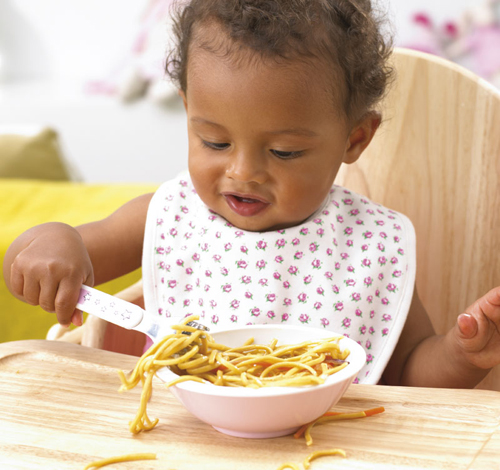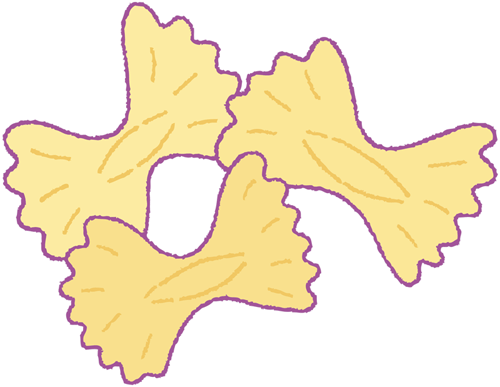Family meals offer a great opportunity to encourage your toddler to try new foods, and to experiment with new tastes. Too many people assume that babies and toddlers want bland, tasteless meals, when, in fact, most of them love to try new flavors, and have sensitive palates right from the word go.
| Q: |
My toddler’s food seems a little bland. Do you have any ideas to help me spice it up?
| | A: |
The idea that you can’t add herbs and spices to a toddler’s food
is long outdated. It’s absolutely fine to experiment with different
flavors and textures, to make your toddler’s diet not only more
exciting, but to introduce her to a more varied diet.
Some little ones might
find hot spices difficult to manage, but focusing on more fragrant
options, such as coriander, lemongrass, thyme, cardamom, cinnamon, dill,
and oregano, are all good options. Consider adding some fruit juice,
such as lime, orange, apricot, or even grape, for flavor, or seasoning
with a little ground black pepper, some wine (as long as it’s cooked at a
high enough temperature to evaporate the alcohol), a little mild curry
paste, coconut milk, sweet chile sauce, soy sauce, or garlic. Consider
offering some unusual combinations, such as adding fruit to meat or
vegetables to puddings; not only will you be bumping up her nutrient
intake, but you will be adding flavor, texture, and fiber to old
favorites. The greater the range of flavors to which your toddler is
introduced in the early years, the more expansive her palate will be.
|
| Q: |
How can I encourage my toddler to try new tastes?
| | A: |
The great thing about hungry toddlers is that they’ll normally
eat what’s put in front of them. So when your little one is tired out
from time at the park, nursery school, or a play date, have a bowl
ready, full of whatever healthy, new tastes you want your child to try.
She’ll dive in before she has a chance to ask for anything else! See the
tips for making food extra-tasty .
|
| Q: |
What are some good ways to introduce new spices and other tastes?
| | A: |
If your toddler is used to plain purées and bland meals, she may
be a little more reluctant to try new tastes. Little ones also have an
amazing ability to spot anything that looks different, such as a sprig
of dill, or a sprinkling of chopped basil, and may pick out the
offending items. At the outset, try using herbs and other spices to
flavor food while cooking, and then strain them out before serving.
Another option is to purée them into a sauce, so they are not
immediately obvious. Once your toddler is accustomed to the taste, you
can leave in increasingly larger bits of seasoning, until they are
accepted. I find that pesto is popular with little ones; see the recipe Pesto Pasta with Chicken and Cherry Tomatoes.
There are many ways to
make meals flavorful, and encouraging an appreciation of different
tastes will help your toddler to develop a healthy approach to food in
general.
|
| Q: |
My toddler wants to eat the same food as the rest of the family. Which family meals are appropriate?
| | A: |
Good choices include pasta dishes, such as spaghetti bolognese, lasagna, and macaroni and cheese. Consider trying chicken satays with rice, tiny beef burgers,
fish cakes with potato wedges, and a fish pie with a cheese sauce.
Simply make sure that salt is kept to a minimum, and everything is cut
small and cooked well for your toddler to manage without choking.
|
| Q: |
Are restaurant meals appropriate for my one-year-old?
| | A: |
Introducing your toddler to different tastes at restaurants is an
excellent way to encourage both an appreciation of food, and a wider
diet. Every different culture uses unique herbs, spices, and other
flavorings and, in reality, none of them are inappropriate for little
ones. While we might balk at offering a toddler a spicy Indian meal,
children around the world are brought up on similar fare with no
ill-effects. I would, however, avoid foods that have high levels of fat,
sugar, or salt, are deep-fried or raw, or contain MSG (an additive).
|
Dining out
Eating out with your toddler
can be fun, but it’s a good idea to make sure you arrive at the
restaurant well before her usual dinner time, and to avoid busy periods,
which can result in delays. Bring along a selection of finger foods and
some distractions, such as crayons, to keep her busy while she waits,
and ask for her food to arrive as soon as it’s ready.
Did you know…
that children love to try
food from different cultures? Take your child out and let her try
delicious stir-fries, grilled chicken satays with peanut sauce, mild
curries, thin-crust vegetable-topped pizzas, spaghetti bolognese, lean
chicken kebabs, grilled fish, and breaded fish balls. A word of warning,
though: if your child suffers from food allergies, it is often
difficult to avoid cross-contamination in some restaurants, so when in
doubt, steer clear.

Pesto Pasta with Chicken and Cherry Tomatoes
Children seem to love pesto, even those who shy away from green foods! Making your own is easy and it keeps very well, although you can use 1/3 cup pesto from a jar instead. Vegetarians can replace the chicken with cubed fresh mozzarella.

10 minutes
13–17 minutes
10oz pasta, such as farfalle, fusilli, or spaghetti 1oz bunch of fresh basil, stems discarded 1/2 garlic clove 1/4 cup pine nuts, lightly toasted 6 tbsp olive oil, plus 1 tsp extra 1/4 cup grated Parmesan cheese, plus extra for serving Salt and freshly ground black pepper 1–2 tbsp boiling water 1 cup cherry tomatoes, halved 1 heaping cup cooked chicken, shredded
Cook the pasta in
boiling water according to the package directions. Meanwhile, make the
pesto: Put the basil leaves in a food processor with the garlic. Process
to a purée, then add the pine nuts and process until the nuts are
minced, stopping and scraping down the sides of the processor bowl as
necessary. Keep the motor running and trickle 6 tbsp of the olive oil
into the processor. When all the oil is mixed in, add the Parmesan and
salt and pepper to taste, and pulse three or four times to combine. Add
just enough boiling water to thin slightly.
Drain the pasta and
set aside. Put the extra 1 tsp oil in the empty pasta pan and add the
tomatoes. Cook them gently until just softened, 2–3 minutes. Add the
pesto and chicken and heat through for 1–2 minutes (the chicken must be
piping hot). Add the cooked, drained pasta and toss everything together.
Spoon onto serving plates and serve with extra Parmesan.
|